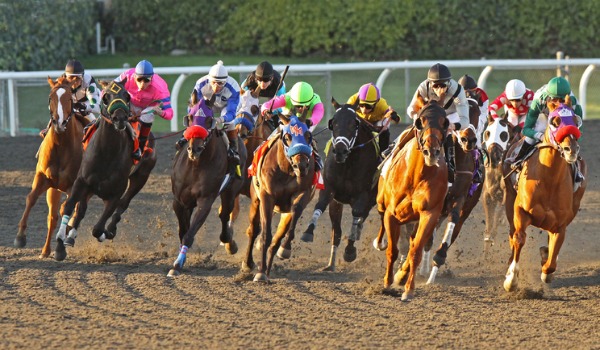Why Do Kentucky Derby Horses Have Such Crazy Names?

The only things crazier at the Kentucky Derby than the hats the ladies wear to it are the names of the horses. As many as 20 horses will race for the rose wreath at Churchill Downs May 7, and the contenders have customarily weird names, including Comma to the Top, Mucho Macho Man, Pants On Fire, and Twice the Appeal.
Such names may seem odd, but there's a good reason behind them. They have to be original, and they must meet many requirements.
In order to compete in the Kentucky Derby, horses must be registered with the racehorse naming-rights authority, The Jockey Club, an organization that's also in charge of tracking all the thoroughbreds foaled in the United States (including Puerto Rico) and Canada. When it comes to enrolling a horse's name, The Jockey Club has strict guidelines – nearly one third of the 60,000 or so names submitted each year are rejected – for what can and can't be used.
For example, the name can't have been used by a previous horse. It can't be longer than 18 letters and can't include initials. It also can't feature a copyrighted term. Horses can’t have the name of a real person unless the horse's owner has written authorization to use the name. The same rule applies to naming horses after famous people.
"The horse's owner would have to get permission from the famous person in order to use their name," The Jockey Club representative Bob Curran told Life's Little Mysteries, citing Barbara Bush – the wife of former president George H. W. Bush – as an example of someone who gave their consent.
Other thoroughbreds that were allowed to be named after celebrities include Fred Astaire, Ann Landers, Mickey Rooney and Jimmy Stewart, according to Curran.
Another requirement is that the name can't be lewd or vulgar -- although throughout the Kentucky Derby's 137-year history, horse owners have managed to creatively sneak a few suggestive names past Jockey Club officials. Here are a few of them: Panty Raid, Riding Miss Daisy, Bodacious Tatas, Junkinthetrunk, and Odor in the Court (because "fart" is one of the banned words deemed offensive by the organization).
Get the world’s most fascinating discoveries delivered straight to your inbox.
Because of these tight guidelines, owners frequently submit several possible names for one horse in the hopes that one of them will be accepted.
Registries that aren't related to the Kentucky Derby also have numerous and varying requirements for horse’s names. Most don't allow repeat names, and although some old horse names are put back on the list of usable names, the monikers of famous horses, such as Seabiscuit, are never made available again.
Traditionally, owners incorporate aspects of the horse's bloodline into its name so that breeders and buyers will be able to recognize its lineage. This can result in some pretty long, wordy names. But horses alternately can also go by a barn name, an everyday name that is usually one word from its full name.
The same applies to the names of Kentucky Derby horses. For example, Man O' War -- one of the greatest racehorses of all time -- was known around the barn simply as Red.
Follow Remy Melina on Twitter @RemyMelina.
This story was provided by Life's Little Mysteries, a sister site to LiveScience.


